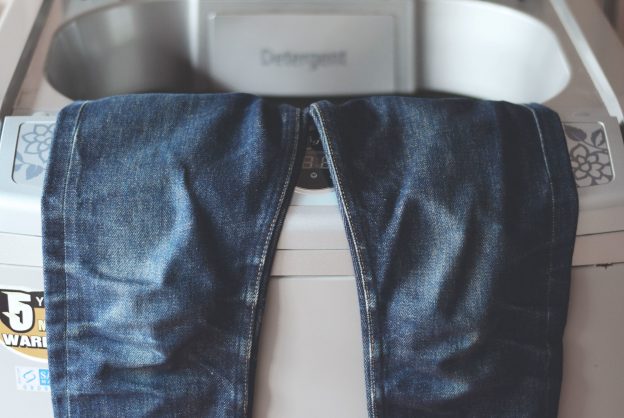When you buy your non-washed denim jeans, probably the first thing you should do with them (before wearing them 😉 is to SOAK them. You can have jeans either from raw denim, which have not been subjected to any treatment at all, or sanforized denim, the material of which (it is exactly the processing of denim, and not the finished product) was previously sanitized to minimize shrinkage.
In the case of sanforized denim, shrinkage has already been minimized and is about 3%. In the case of raw denim though, be prepared to experience shrinkage of about 10%.
As for soaking jeans, there are very different opinions and arguments. The following practices should not be taken as some mandatory rules, after all, jeans are exclusively individual subjects of your wardrobe and in due course, you will choose your own algorithm of actions. But, it’s a great way to start:)
Why do we need to soak the jeans?
- When it comes to raw denim, this procedure is absolutely necessary to ensure that the jeans get to the size decided by the manufacturer.
The vast majority of these jeans have some margin, manufacturers having already calculated that jeans will inevitably shrink down after soaking and drying. When soaked and then dried, the jeans will match the tag size. The style itself will also be less baggy.
- Washing out the remains of starch that make the jeans excessively rigid.
In order to make jeans easier to cut and sew, denim is pre-treated with starch. Even a low-density material, when impregnated with starch, will initially be quite stiff. In addition, sometimes excessively hard denim can cause the premature appearance of holes in jeans, working in places of folds, as an abrasive and leading to the destruction of tissue. Partially washing denim to get the starch out with soaking makes the material much softer.
- Washing out the excess of indigo dye
Each sewing thread, even before they are woven with denim, is carefully painted many times with the “rope dyeing” method, therefore, the indigo is very noticeable in many jeans initially. Soaking the jeans allows you to get rid of the excess dye. Don’t be afraid that your jeans “lose color” – this is the standard procedure and the color is just a aftermath of the excess dye.
- Soaking the jeans to give them the original shape
As we already know, jeans made from cotton threads can both shrink and stretch. Especially when it comes to denim woven from cotton with a long fiber. This denim is extraordinarily comfortable to wear and soft almost immediately. However, due to its properties, it also tends to stretch. Periodic soaking for a long time wearing worn jeans (without washing as such) allows them to return to their original dense planting if they are stretched too much.
1) Delicate soak in cold water
As already mentioned above, this method is well suited when you just need to “shape” your jeans a little or make your new jeans a bit softer.
Immerse your jeans in any container with water, the best is to do it in a normal bathtub. Keep your jeans in there, and give them the opportunity to soak up the water. A couple of hours will be enough. If you see that water has strongly acquired the color of indigo, don’t worry – it’s just the excess of the dye that comes out. The color of your jeans will be just dark and saturated. Some jeans, painted with natural indigo, can initially dye the water not to a dark blue, but rather in a reddish hue. No need to worry here either, it’s just the characteristics of the dye.
Next, you just have to take your jeans out of the water and hang them in a convenient place to dry, without squeezing or twisting them.
After this procedure, the starch will be partially washed. Despite the fact that the jeans will initially be quite stiff, they will carry much faster.
2) Soak in hot water
Warm or hot water is recommended for soaking raw denim jeans, shrinks about 10%. Typically, the shrinkage procedure uses water with a temperature of not more than 60 degrees. At higher temperatures, there might be cases of damage to the leather patch of jeans.
Here, exactly the same way, Jeans are soaked for a couple of hours, after which it’s best to dry them in the fresh air. Drying in the hot sun will greatly strengthen the shrinkage of jeans.
3) Soak with a washing machine
It’s not about washing only, it’s about soaking jeans in a washing machine without using detergents. This method is good if you want to achieve the greatest possible shrinkage of jeans, close to the factory one wash.
Most of the denim sits when using spinning. To use the temperature more than 60 degrees is not worth it, since it will fraught with damage to the patch of jeans and more of a loss of dye (so if you decide to sit in jeans in extreme conditions, do it at your own peril and risk).
After the jeans have been taken out of the washing machine, all creases on the fabric should be carefully spread out, or you might get ugly luminescent stripes after the jeans have been dried.
4) Soaking in the salty ocean or sea water
Soaking jeans in the sea or ocean water carries a certain aesthetic ritual. In the end, denim and sea water – it’s beautiful! Technically, this method is no different from the usual soaking in the bathtub. However, there are some practical nuances. Salt water in the opinion of many denimheads fixes the dye indigo, not allowing the jeans to lose color.
Technically, this method is no different from the usual soaking in the bathtub. However, there are some practical nuances. Salt water in the opinion of many denimheads fixes the dye indigo, not allowing the jeans to lose color.
5) Soaking with the addition of vinegar
A very exotic way. In fact, it is to some extent a “home” alternative to sea water. The thing is vinegar also will fix indigo, not allowing the dye to wash out. For those jeans lovers who are very sensitive to the color of their jeans and tend to eventually get the maximum contrast between the withered and unshrouded piece of jeans, this method may well be recommended.
6) Soaking jeans on yourself
The method is very exotic. consists of Immersing yourself in the water wearing the jeans)) For example, in a bath. The idea here is to shrink your jeans exactly to your shape. If you watched the movie Quadrophenia, then you’ve surely paid attention to the main character walking around the house in wet jeans, this is exactly what we are talking about here. Also, (fun fact!) this method was practiced in the time of cowboys, and thus, justified by the fact that the dimensions were much smaller than now, and size was adjusted by the figure with the help of water and drinking bowls for horses. If you have already begun to soak and shrink down your jeans in this way, try to avoid sitting during the drying process, so jeans will not stretch because of the angle of your knees when sitting.
7) Soaking jeans in certain areas
Sometimes the received jeans are perfect for you even before shrinkage in the belt and you would not want this part of the jeans to shrink down after soaking and drying the jeans. No problem! You can soak your jeans to the waist. So you will get a shrinkage along the length and you don’t have to stretch and loosen the belt to fasten it after shrinking.
For some people, soaking jeans has a purely practical meaning, allowing them to be brought into the most comfortable condition, and for others, soaking jeans has a greater aesthetic value, allowing you to preserve the color of indigo and get the maximum contrast of your wonderful jeans. In any case, the Japanese denim is a fairly wide field for activities and experiments.
Think Blue. Think Denimio.

